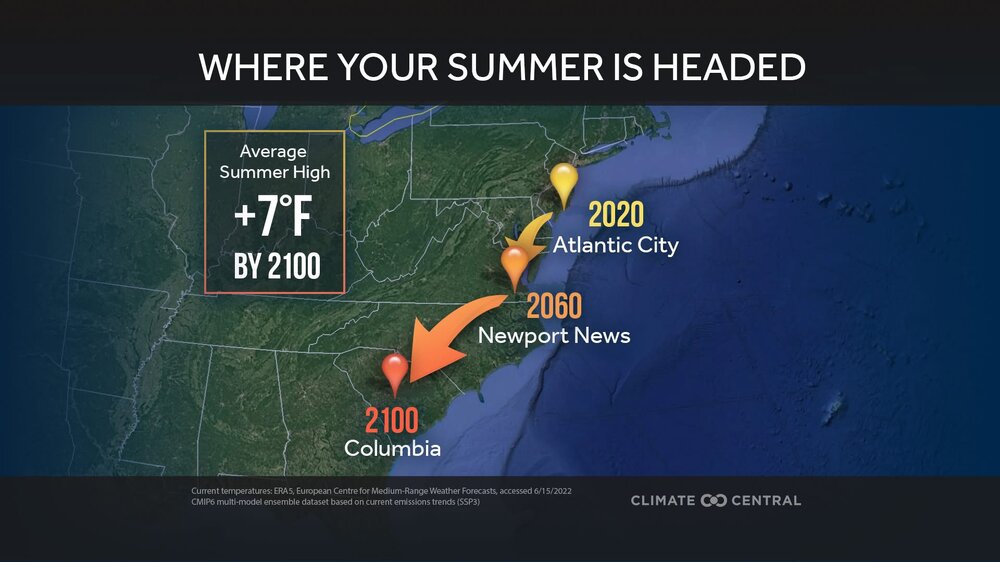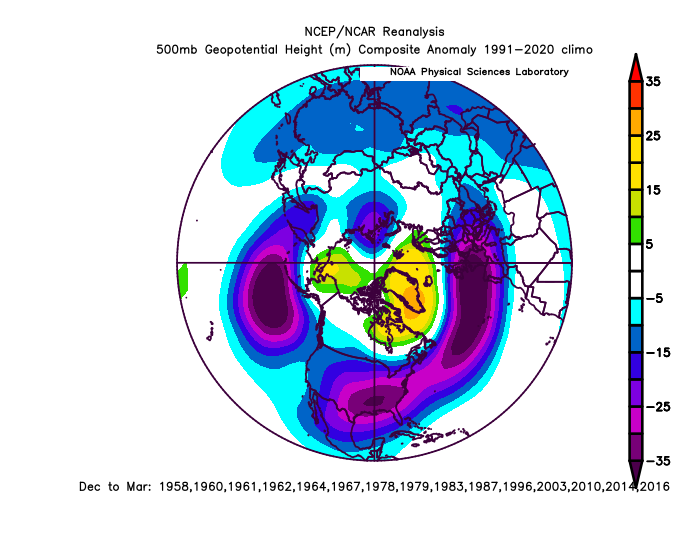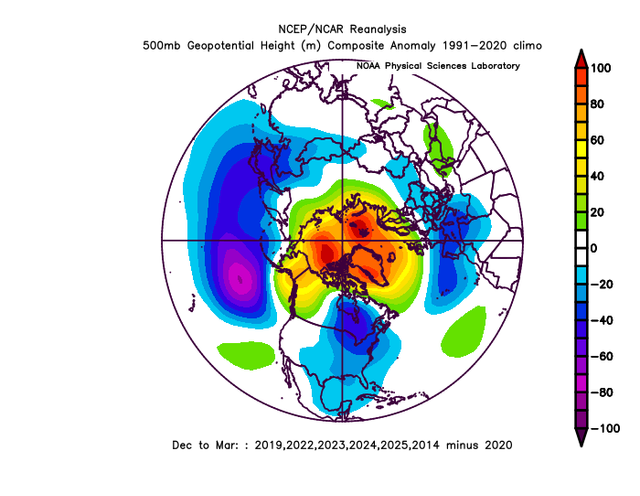-
Posts
26,604 -
Joined
-
Last visited
Content Type
Profiles
Blogs
Forums
American Weather
Media Demo
Store
Gallery
Everything posted by psuhoffman
-
Good point. Both the observation and whether it even matters. 6/7 of the wall to wall cold season enso neutral years the last 30 years were below avg snowfall at BWI. The numbers suggest our chances of a snowy winter don’t change much between a weak Nina and enso neutral. Actually what’s happened to enso neutral winters accounts for most of the degradation of our snow climo. Our typical snowfall during enso neutral has degraded worse than any other subset to the point there isn’t much difference between Nina and neutral now. To really simplify it we have about a 60% chance of a snowy winter in a Nino and a 20% chance in all other winters. Overall in any given year we only have about a 30% chance of a snowy winter. Our climo has become an occasional fluke snowy winter or two surrounded by many many years of dreg. That trend started well before this current string of futility.
-
At least we finally got rid of Franklin. I was rooting for them to lose so this would happen. I stopped even rooting for them recently. I can't waste my time supporting something doomed to fail in the end. And I couldn't stomach the weak pathetic loser alumni attitude anymore, where they were content and happy just to go 10-3 every season and enjoy some trip to the "Who gives a flying F bowl" each year. PSU doesn't have the recruiting classes of Alabama, Georgia or Ohio State, no one should expect them to be competing for a national championship every season like those programs do. But I compare it to Auburn and LSU, two programs who do have similar recruiting rankings as PSU, who have won championships in the last 20 years. They both also have more losing seasons that PSU under Franklin, but who cares. No one remembers that LSU sucked the year after their last championship, no one cares. There is one winner and everyone else is some degree of loser. This just have a winning season loser BS is sickening and I couldn't stand it. I hope now they get a coach that gives them a chance to upset some of the big schools and have at least a prayer of winning a title one year. Yes, playing a more aggressive style can also lead to losses and ads more variance but I was not content to just beat up on the pathetic schools on our schedule every year and lose every time we play a top 10 team.
-
As an outsider who follows the Raves but with no rooting interest one way or another I rate the coaching in between most others. I was never as high on it a few years ago when almost everyone considered the Ravens staff one of the very best in the NFL, and I am not as down on it now. The team is devastated by injuries in key spots. I'm not sure anyone could overcome that, especially in a league that features as much parity as the NFL does, when a few key players separate the best and worst teams. Look at the Eagles...they got hit by some injuries to weak spots in their roster and they suddenly look like crap the last couple of weeks. Take away 3 or 4 key players and they aren't nearly as good a team anymore. The Ravens have been hit even worse! My opinion of the inability of the team to win a super bowl with their recent stacked roster is its 90% on the QB. Lamar has been perhaps the best regular season QB in NFL history. But his playoff performance has been below average. Last year he was better, but before last year his playoff QB rating was BELOW 80!!! You can't win with that. That is below even a "game manager" QB level of competency. One season he was injured in the playoffs and that had nothing to do with him. And last year he was better and perhaps in another parrallell reality they do win the SB last year...but the receiver drops that easy catch at the end...and who knows. He played well enough to win and that one time someone else let him down...and maybe the Ravens don't have the same mental block the Bills do against KC and they don't fail to convert a 3rd or 4th and 1 like 27 times and they win the AFC championship last year. Dunno about beating the Eagles...they were a freaking freight train at the end of last season...but who knows. But that was one game...if Lamar played like he does in the regular season in the playoffs across the board the last 7 years...they probably would have won a super bowl and that has nothing to do with coaching.
-
The upper level low to the NW of the STJ wave acted as a suppressive feature instead of phasing in any way. The upper low acted more like a TPV instead of a typical upper low in the end. That was one of the biggest mistakes I made the week leading up to that, "as the upper levels trended better the surface was worse" I kept saying, but I was not correctly seeing, and I think @Bob Chill was the first to identify, the upper low was actually the problem not a solution. Typically an upper low tracking just to our NW would indicate a surface track maybe even too far NW for what we want, not suppressed, but not if that upper low acts like a polar vortex, and squashes everything around it instead of interacting with it. If you are asking why it did that though I don't know. But there must be something about a Nina though because there are a lot of examples of storms that hit that area (immediate coast from NC/VA Beach up the Delmarva) in Nina's. My best guess is it's a matter of the energy balance between the northern stream and the southern stream. You have a strong enough STJ wave and it can bully its way without much NS help. You get a balance between the two and you can get a phased event where the NS phases with a STJ wave and get a storm that way. But if the balance of energy is too skewed towards the NS, it acts as a suppressive force and squashes everything. This is our biggest issue with Ninas. We are too far south to typically get a lot of snow from NS dominant waves. We can get some, a clipper, a NS wave that tracks further south than usual, but they aren't going to be huge snowstorms here, they can amplify along the east coast and get places further to our north with a bigger event...but were too far southwest typically to get a big storm that way. And if the NS acts as a suppressive force we end up too far north for the weaker STJ waves you get in a nina. So we end up in between. That is why the mean snow minimum for ninas is centered right over us. The odds of an above average snowfall season go up to our north and south.
-
Yup… The north pacific just never coupled with the enso. Then we got lucky with the Atlantic also. It’s happened recently in ninos also where the pacific pattern never took on a canonical Nino configuration. It was just a fluke. A Nina that didn’t act like a Nina. It happens but it’s not something I’d ever expect again. If it does happen again great but I’d never predict it before hand.
-
A warmer enso actually correlates slightly warmer for us, but what makes a warm enso "snowier" is that it gives us multiple ways to "win". We can still get a colder pattern sometimes in warm enso...and then it's a possible 2003, 2010 type thing. Those are the once in a blue moon blockbuster winters. But even in a warmer year we can still "win" if we just time up one of those STJ storms with a rare colder period. 1983 and 2016 for example. And of course we get lots of years somewhere in between...but with an active STJ we just have more chances to get snow, even if overall the winter isn't cold...we just have to time up a couple of the storms. The problem with a fading nina is that we don't get the advantage that actually makes warmer enso better...the stronger STJ, which typically doesn't take effect until we get an actual warm enso. So I dont think there is really an advantage to a fading cold enso for our snowfall. That said, I do think a fluke can always happen. Something like 2014 for example, which was a wall to wall enso neutral year, could happen but it's just so rare it likely wouldn't show up in such a small sample just by random probabilities. If we had records that went back longer we probably would eventually see a snowy winter in a cold enso fading to neutral, IMO. But I think we can say it's not MORE likely that if the enso simply stays cold since we do have some examples of a snowy winter in a wall to wall cold enso winter...and absolutely NONE in a cold enso fading to neutral. Again, due to small sample I think that is somewhat a fluke, so saying it is WORSE is a step to far imo, but saying it is better also has no support.
-
I had a few minutes so I found my data regarding a cold enso fading to neutral during the winter...and it's FUGLY, as I thought I remembered. Now, this is an extremely small sample size so it's always possible this is a fluke, but there is no actual results based data to support the idea a fading nina is a good thing. All the years where we had a weak cold enso heading into the fall that faded to neutral by the JFM period and BWI snowfall that winter. 2022-23: 0.2" 2016-17: 3" 2001-02: 0.3" 1983-84: 14.5" 1971-72: 13" 1964-65: 18.6" 1956-57: 19.1" The last 3 examples of this were some of our worst snowfall winters ever! Additionally, while snowfall was somewhat better with the older analogs, snow climo was significantly better then also so make sure to consider that. For example, that 18.6" total in 1965 might seem nice, except that was the least snowy winter of the entire 1960s for Baltimore! You have to apply context. A year with 14 or 18" of snow might seem ok now, but in a time period when BWI averaged close to 25" it would have been the equivalent of a single digit snowfall season now.
-
I’ve pointed out another flaw in his opinion above in the past. DT has previously stated a Nina shifting towards neutral during the winter as a good thing and used it to justify a forecast for a snowier winter. But when I ran the numbers there is absolutely no evidence to support this. Actually, a week Nina transitioning to enso neutral produces our absolute worst snowfall results of every enso grouping. That said, the logic he has provided behind why the enso becoming more neutral SHOULD be good is sound. The problem is it hasn’t happened. There must be some lag effect. I’ve theorized that it’s bad because you tend to still get a lack of STJ following a Nina into neutral, but Nina’s can actually be colder and if you lose that you end up with a still dry but warmer pattern. We need an actual Nino with the associated amplified STJ for it to help us.
-
The PDO. We’ve been stuck in the most hostile PDO regime ever for like 6 years. We’ve set record low monthly values numerous times. Overall it’s been oscillating between moderately low and record low for the whole time. Until that changes and we break out of this current PDO cycle our snowfall luck won’t change much. We will continue to have god awful years with some meh kinda ok when we get lucky years but our baseline bar is going to be very low with this kind of PDO base state. We aren’t just in a -PDO. The longer term PDO cycles can last 15-30 years but within that are shorter term mini cycles and we are in an extreme -PDO cycle within the longer PDO. These are particularly hostile to snow. Yea we’ve had some previous similar cycles and those were also bad for snow. This cycle is similar WRT snowfall and what we would expect if you adjust snowfall downward for the 15-20% of snow climo we’ve lost. So this period is similar to say the extreme -pdo of the 70s and 50s but the snowfall results are about 20% worse because the whole snow climo has deteriorated about 20% regardless of the pdo. What’s troubling is this current extreme PDO is now extending past what is typical. These super negative periods don’t usually last beyond 5 or 6 years. So the were due index is through the roof. But I’ve also seen some speculation that the -PDO is being or at least enhanced by factors linked to longer term climate changes. So I guess the big question…is there another cyclical thing being added on top of the cycle we’re talking about. We should see snowfall improve once the PDO improves. But is the PDO taking on more of a negative base state in general?
-
This shit has to end eventually. But it feels like we’ve been saying that for a long time now.
-
We do not want anything that's happening right now! Snark aside, it's not a super strong correlation but in general yes. Same for snowfall, its a super small sample but winters following an October snowfall in our area tend to end badly. You misunderstand, a cold October means a warm winter. A warm October also means a warm winter.
-
That’s one of the reasons I’m less sure of a total dreg outcome right now than I was heading into our last cold neutral/weak Nina/ horrific PDO winters, but keep in mind 2014 was the most extreme outcome of all similar analogs. Even if we got another 2014 “type” winter it would be extremely unlikely to result in that much snow. That was an anomaly. Also, we’re not arriving at the warm pool through the same larger scale mechanism this time as @Bob Chill pointed out and that matters. SSTs can be just as much an effect as a cause.
-
He is giving me too much credit. It’s because people take one part of what someone says (if it confirms what they fear or want) and run with it. I did state in the fall leading into both those years that we had a very high chance at a total dead ratter winter. But it was based solely on the base state of the PDO and enso heading in and probabilities. I didn’t actually call TOD on those winters for sure until around Xmas.
-
I had a really bad feeling going into both 2019-20 and 2022-23 but things don’t look as hopeless right now. The JFM ONI was actually enso neutral those years and strongly -pdo enso neutral winters have been the WORST subset for us lately. Ninos have been slightly better mostly because they’ve been colder. Enso neutral have been warmer but still dry, at least when what little cold was around. That said we need the PDO to improve somewhat. It can be negative but not -3 to -4 that’s nuts. If winter ends up enso neutral AND the pdo is below -2 we provably get another 2020, 2023 dead ratter. But those two things aren’t written in stone…YET.
-
There are outliers to every subset but Nina’s in general are colder and drier than other enso states lately. That produces less variance across our region due to meso scale climate factors (elevation, slight changes in latitude). So in general that equates to better for places further SE in our region and worse for places NW wrt “normal”
-
Problem is some of the same large scale forcing that causes cold now can cause an opposite reaction mid winter. That’s why snowfall in October has no correlation with a snowy winter.
-
Phillys mean is a little higher than Baltimore. Baltimore is also in its least snowy 7 year period ever. Both are probably within a really small margin of each other wrt suckiest snow city in America recently.
-
I think it’s a combination of a result of a general pattern and bad luck making it worse. We have been in a Nina like pattern a lot and it’s more common in that type of pattern to occasionally get west to east snow events that don’t phase and instead are suppressed by the northern stream. On top of that the storms that were phased all tended to end up too far north for Baltimore to make up for the southern misses. March 2017, March 2018, March 2019, 5 storms in 2021, Jan and March 2022…all those features big snowstorms that the big snow missed just NW of Baltimore. The combo has created a gap zone around Baltimore that’s probably the greatest snowfall minimum WRT mean on the US over the last 10 years.
-
-
True. But keep in mind the heights in my plot are being skewed lower by some of the older years being measured against today’s means. The same pattern as say a 1958 or 1960 wouldn’t produce nearly as negative an anomaly today (by 1960s standards) and a might more positive anomaly over the high latitudes as well. Of course we could argue whether the same pattern would even produce similar snow now given the mean heights have increased significantly.
-
@Stormchaserchuck1 it’s not too surprising the mean anomaly you posted didn’t lead to snow most of the time. This look is decent but not really our snowy look this is the snowy season composite for BWI Note the negative in the TN valley. That’s the sweet spot. The pacific and high lat look is close but with the anomalies centered to our north it’s a cold dry look. We really want a negative anomaly centered to our SW on a winter mean to have a good chance of a snowy winter. Almost every decently big snowstorm has that. And it takes us multiple wasted good opportunities to score a hit most of the time. And we can’t get a snowy winter without hitting a couple times. So…it’s really hard to get a snowy winter without a negative on the seasonal means there. No mot impossible. It’s happened a few times. But betting on something that’s only happened a few times in 75 years isn’t a good bet. 90% of our snowy winters have a negative centered to our southwest for the season.
-
I’m not an expert but it looks typical poleward EPO ridge Nina pattern imo. There are two typical canonical Nina long wave patterns and neither is “snowy” but the more poleward pacific ridge pattern is preferable and does shift whatever cold there is into the east more. Problem is both them to be dryer and lack the gulf storms we need to have a snowy winter. But a good example of the difference is for Baltimore a poleward ridge Nina has a median snowfall of about 14” and a flat ridge Nina median is 7”. One is bad and the other is awful so we take the bad option. I excluded 1996 from these numbers because it skews everything given the small sample size and extreme results Some extra observations: I keep hearing don’t worry about the warm everywhere look but over the last 10 years we’ve had a lot of warm everywhere results so…. Also yes the LW flow looks decent but recently a decent LW pattern absent a good STJ gets us simply bad snow results vs the god awful snowless results of some winters recently. So purely based on this I’d say it’s not indicating a total non winter like 2020 and 2023 but most definitely not hinting this is the year we break out of our funk either. It implies likely a typical Nina with likely snowfall in the 7-16” range in the 95 corridor.












